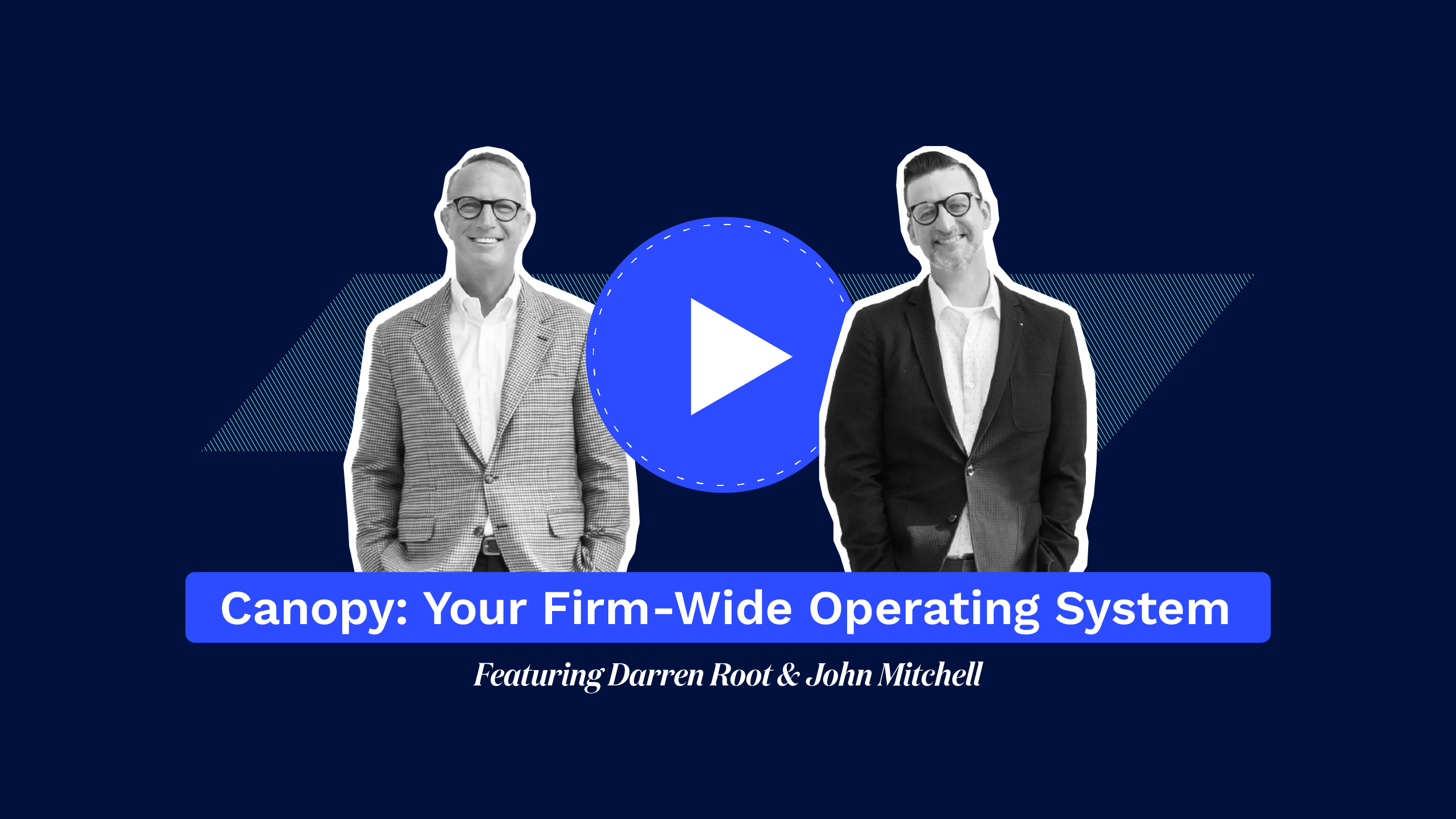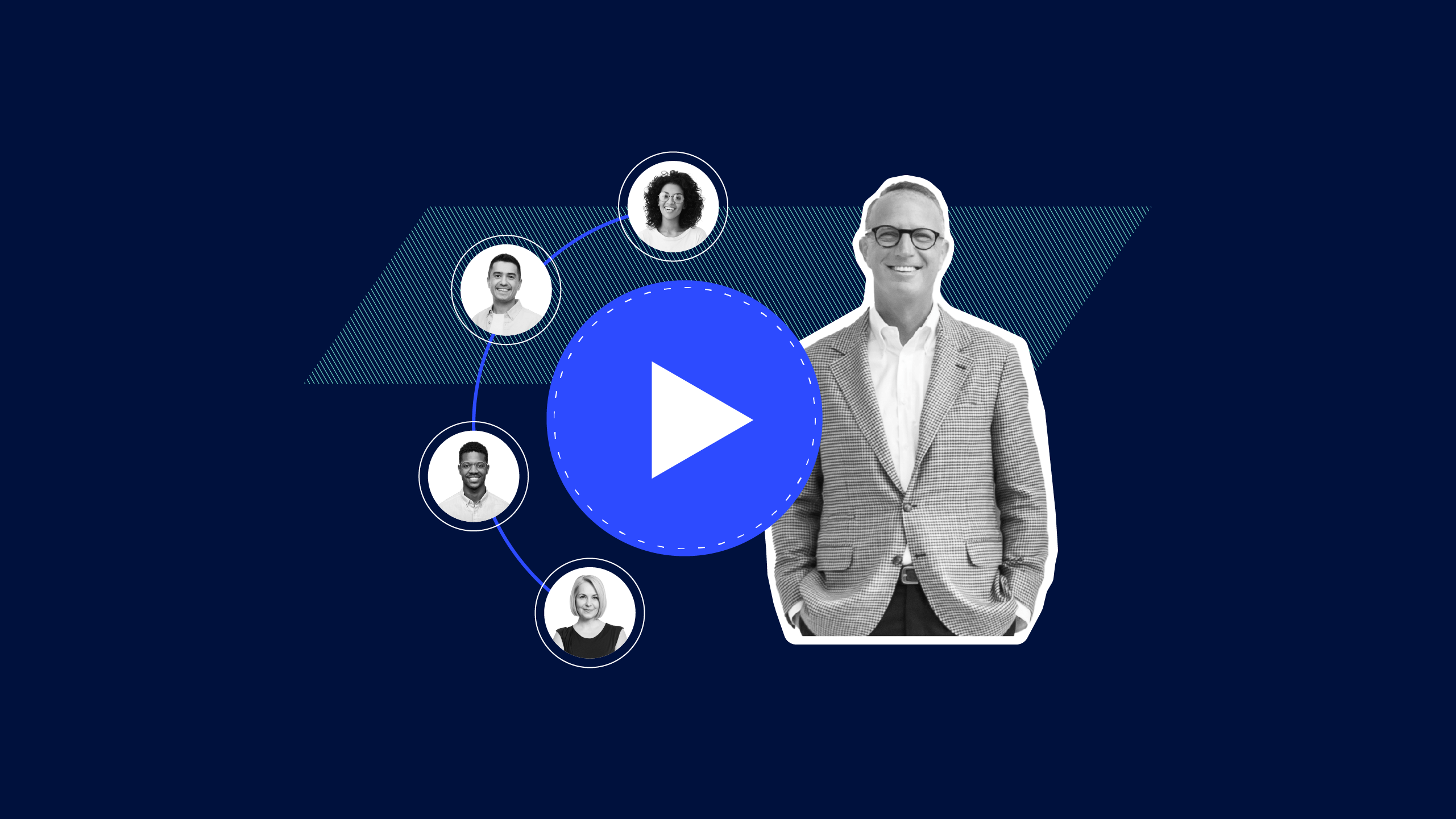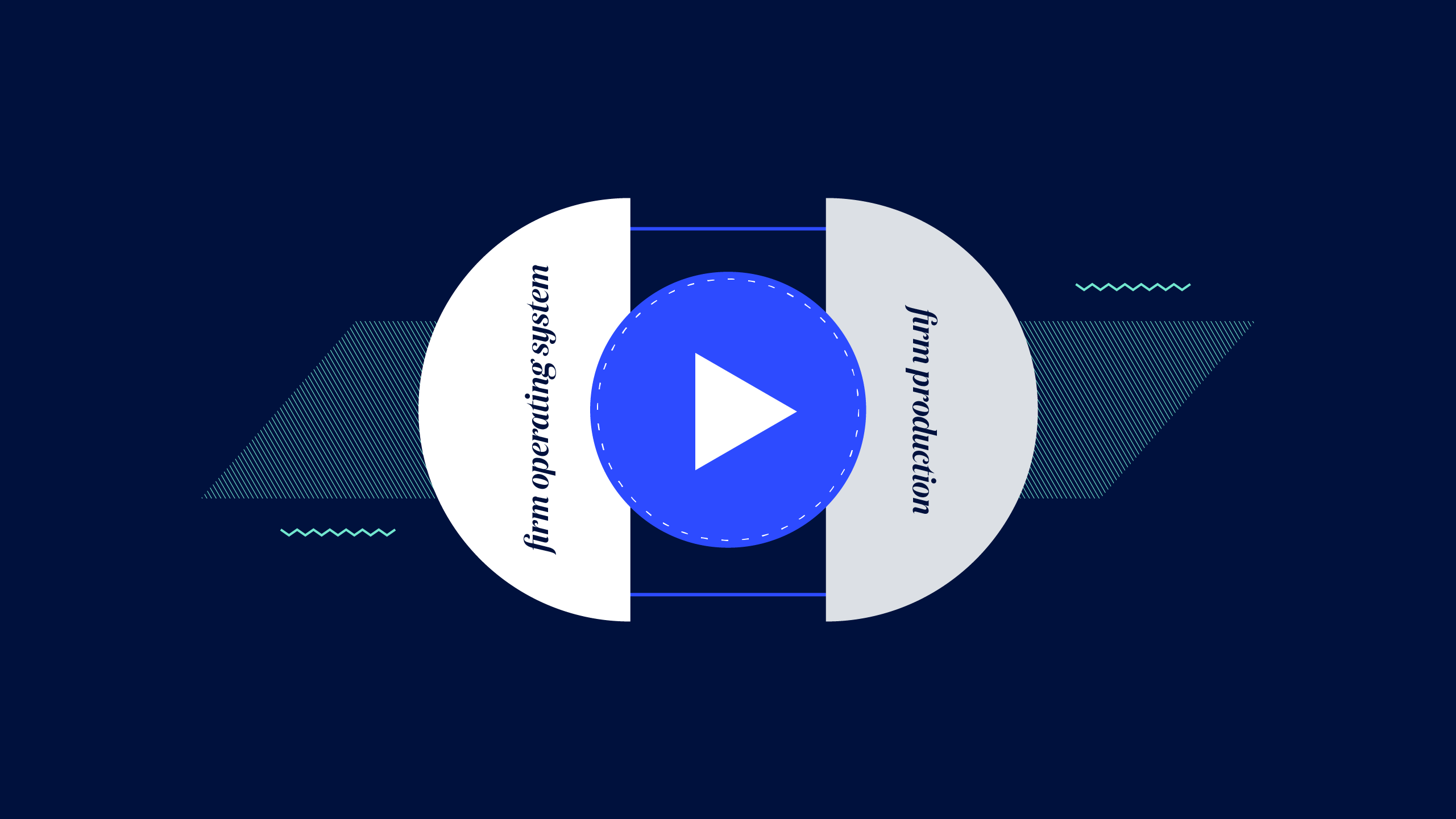In this episode, John Mitchell and Darren Root discuss the evolution of firm management in this video series as Darren reflects on his journey of using various practice management tools in his firm. They emphasize the importance of streamlining tools to reduce complexity and improve workflow efficiency. The focus of this episode is on transitioning from multiple point solutions to a comprehensive firm-wide operating system to enhance client experience and firm effectiveness.
Video Transcript:
John Mitchell: [00:00:00] Hello. Welcome. My name is John Mitchell and I'm here with my friend, Darren Root today. And we are excited to have a conversation with you today about, um, some evolution in the way that we think about firm management and Darren, uh, we've been thinking about this for a long time. Excited to get a chance to, to dig in today.
Darren Root: Yeah, I think today's going to be a great topic. John, we're really setting up a series of topics, um, that you and I are going Really this concept of firm wide operating system. And we'll talk more about that later. The series that we're putting together, we're going to take it bit by bit over a number of episodes.
So stay tuned.
John Mitchell: Anybody that may not know your name and know what your background is. Um, let's talk just a little bit about why you're so passionate about this and, and, and what you're bringing to this today.
Darren Root: I've spent the [00:01:00] last 40 years, uh, certainly the last two years. of it using some level of practice management tool inside my accounting firm.
It's always been helpful, but it was not holistic. Uh, I think I should say, and the last several years I've been really looking at different tools, solutions that, that could serve a more holistic Uh, management of my, my firm, my interactions with my clients, my documents, all of this stuff and really have narrowed it down to, uh, a tool that we've aligned well with John, which is, is Canopy's system.
You know, I've, I've made a lot of software changes over the years, John, in, in the firm, probably none more, um, than, you know, the tools in and around my firm. Firm wide operating system [00:02:00] because this used to be really disjointed, you know, I, I started with this, uh, uh, well started with pencil and paper, but fast forward a little bit, you know, I, as, as I moved into the practice management world, you know, used to what practice management meant was tracking invoices out, managing engagements through you.
Projects and tasks. So, so sort of managing workflow. Uh, and there was. An ever so slight or light, um, I would say contact management system. Uh, so, you know, really not even the concept of CRM, that kind of stuff, you know, and then document management was disconnected and, um, that, that, that's sort of where practice management started for us.
And then. You know, as, as things like Amazon and Apple and modern technologies, [00:03:00] Google started, you know, becoming a part of our everyday lives, um, client expectations started shifting a little bit. They wanted to be able to pay online, you know, they wanted to be able to get a digital. They wanted to be able to digitally sign an engagement letter.
Uh, and so what I found John is my, my original practice management tool wasn't evolving with the times as, as fast as, as my customers expected it to. And so I was starting to buy all of these other point solutions to accomplish You know, just remaining relevant or, or, or being modern in a way. And every time I introduced one of those tools into the firm, that was additional change for the firm.
It was another database. Uh, and before I knew it, you know, our tech stack inside of our firm had ballooned to probably, you know, [00:04:00] I don't know, 25 different solutions, maybe 30. Uh, and just a lot of frustration among the staff with, with all the complexities of databases that didn't necessarily talk to each other, uh, created a lot of complications really in managing the firm.
John Mitchell: Yeah. You know, I get a chance to talk to firms pretty much every day, mostly small firms and all of them are trying to reduce the number of variables. That their team has to deal with right now. And man, if you think about just use the number 25, that's the number you came up with. I think we see somewhere in the average of between 25 and 30, what you referred to as a point solution.
Um, things that are kind of just scratching an itch that the firm sees and they just keep introducing them. And so pretty soon you've got. Permissions for everyone. You've got credentials for every single thing. You've got all of these opportunities for passwords and for getting the password that belongs to this account and all of the security issues that are included there.
And [00:05:00] before you know it, you just end up with friction. All over your firm. And the idea of being able to take what used to be this disparate list of point solutions that were really valid, um, reasons to have solutions and bring them together so that we can remove these variables and create some more intent behind our workflows.
Darren Root: As I talk to firms, John, I, I, um, I like to get the owners thinking about the least number of. Solutions that they need to manage their organization. So the goal is to have as few solutions. As possible to create the maximum effectiveness and client experience and finding that that balance is important. I really put solutions in a, in a, in a few different categories.
There's this category that is. Firm wide operating system, which is everything that it takes sort of to [00:06:00] run your firm, communicate with your clients and do all that kind of stuff. And then there's the tools that a firm has is more production oriented, like their client accounting set of tools or their tax return preparation set of tools.
What we're going to be talking about in our series is the, the firm wide operating system set of tools. And the goal there, if you could get that down. To one tool that could run your entire firm and have a modern experience. I think that's the goal we're after, John. And that's, that's really why we engaged with canopy because canopy has the same goal that we have.
How do we take all these different points solutions that have popped up that have become companies and turn those into features? Inside of that single firm wide operating system tool. So what used to be document management was out [00:07:00] there as a, as a company or, you know, a product or client communications was out there as a product or getting your engagement letters signed or taking payments, you know, and there we've just listed, you know, four or five, right?
All those become features inside of a, a document. A modern firm wide firm wide operating system, you know, at some point after I left, uh, one of the big, what was the big eight is now the big four, uh, you know, I started my own accounting firm, but I always had this idea in my mind, John, that I wanted to run a firm differently than my father had run.
And, you know, what I saw in him was this guy who, um, got up at 4 0 AM every day. Um, went to the office, busted his tail, working hard, you know, doing tax returns on really, uh, TV trays in the, in our family room at night and on weekends and [00:08:00] just really working hard. Uh, and, and a lot of ways he, he wore that as a badge of honor.
Uh, the, the idea that he, he could work, you know, 80 hours a week. Well, I entered the profession and, um. That was actually the last thing I wanted to do, but you do, you find yourself going down this path of man cranking through the work. And there's, there's a lot of reasons for that. 1 of them is the lack of integrated systems and efficiencies.
Yeah, we should have and the intelligence we should have off of our client base. And so I'm passionate about helping accounting firms not repeat, uh, the challenges certainly that my dad had and that I started with and evolved away from. And, and that's why I'm so passionate about getting an operating system for a firm.
John Mitchell: And 12 to 15 years ago, you got me involved. My job is, uh, been for the [00:09:00] last 12 years or so, um, to work with Darren and work with accounting firms to really emphasize getting the life that you want to live out of your firm, um, and not letting your firm run your life. And so my job has been. Been to help with firm culture.
Um, it's been to help with staff culture and to, to do whatever it takes to create a firm that supports the life around it and not just consume that life. And so it's led us to the conversation around intent. What happens? Nobody starts their firm to Darren's point and goes, I just want this thing to eat my whole life.
What happens is it happens passively and one day becomes another day. One accepted bad client becomes another one. One bad piece of software that gets accepted becomes another. And before you're, you know, you've created something that's running you. And so the idea between behind the, the firm wide operating system really begins with the word intentional.
It means [00:10:00] taking anything that may be in your firm as you're speak, as we're talking right now, and maybe you're thinking going, Oh my gosh, that's us. You're not alone. Most firms drift into becoming something they would have never intended to be. The idea of a firm wide operating system is to be intentional about the software, about the tools and the resources and the processes that you bring into your firm.
So you can build the firm.
Darren Root: You know, the thing I would, um, add, John, is that the idea of firm culture and, uh, you know, employee satisfaction is not disconnected from the concept of what tools you select, the workflow that you have, the, the, the way you interact with clients, the kind of clients you take on all this stuff.
Is connected and it's really important to have a great business model Which we you know, john and I you and I spend a lot of time talking about But also [00:11:00] having the tools that support that business model that takes As much friction as possible Out of the routine the the way you like said interact with clients the way you manage documents uh the way you Know who you're a clients are, are your ideal clients?
All this stuff, uh, comes together to create a great culture.
John Mitchell: Yeah. We're going to be digging into each of those features. Um, throughout this series, we're going to be looking at the kinds of features that, that you're already using inside your firm, um, and driving towards one united piece of, uh, firm wide operating system tool.
But I, the thing, Darren, that I would love to talk about as we. As we dig into the beginning of this is the heart of, um, the, the firm wide operating system, which is the customer relationship manager, part of this, the, the database, the client record, which we believe and have for a long time is at [00:12:00] the heart of the firm.
Darren Root: Yeah. I mean, I think everything inside of a firm, John centers. Around the client, right? And that client has a set of demographics. You know, it's, it's got the client name. It's got the contacts associated with it at the heart. Is that connected to that are all the pieces. Whether it's your engagement letter or your engagement letters or your documents, all those things come off of the client record, uh, your, your marketing to those customers, what they're buying from you, all that stuff comes off of that.
John Mitchell: You know, my, my wife works in an accounting firm, um, here in town and I was in her office the other day and the phone rings and she picks it up. And I looked over her shoulder. And as soon as she picked up the phone, she opened her customer relationship manager up and looked for the name that she was talking to.
And was immediately able to see all kinds of notes about that specific customer. And what it made me feel like at the time is [00:13:00] the firm has enabled her to put one of the most valuable assets that the firm has, which is that client, which is all the clients in the firm at the time. Forefront right at her fingertips to be able to provide them the kind of customer service that we expect when we go to a great hotel, when we go to a great restaurant, that they would know who we are and be able to serve us more holistically.
That's why it's so important that at the, at the heart of firm wide operating system is this place to store data around your customer.
Darren Root: I mean, just think about it, John. If, if everything evolves around that client record and you can see everything associated with that, that client communications, everything.
Imagine how much friction gets taken out of your staff's day and how much better you can serve. The end user customer, if, if that is at your fingertips,
John Mitchell: you know, Darren, there, we talk [00:14:00] about this, that there's data all around your firm right now. It's everywhere. If you could see it, it would be like, you know, little particles all over your firm.
The idea of taking a CRM or a customer relationship manager and, and sucking all of that data in so that you can take a deep breath and leverage that data to then serve back. Your clients is really what it means to be in control and to be intentional about your firm.
Darren Root: Yeah, I, and I think what we're talking about through this series, John is, is bigger than a CRM.
John Mitchell: Yeah.
Darren Root: This is really more about a firm wide operating system that incorporates so much more, um, than just the relationship management piece.
John Mitchell: I know you love to think, um, and, and move firms forward. Talk about the reason that today is the day, the reason not to wait another year. Um, before you get this right.
Darren Root: Well, there there's a number of reasons right now, John One, I believe that Canopy has incorporated enough features that now is the time. Mm-Hmm. , I believe [00:15:00] that artificial intelligence is imminently on us and is only gonna make, um, the evolution of our firms go faster. I think there's a lot of. Friction inside of firms that's causing, um, challenges with your teams.
Uh, so staffing becomes a challenge and putting this off another year. Doesn't make any of those things better. Yeah. It's just kicking the can down the road. So the planets seem to be aligning right now that now is the time.
John Mitchell: So over this next series, what we're hoping you'll get is a yes. An overview. Yes.
Um, some demos, we're going to bring in some really smart people to help us with, uh, being able to show you exactly what we're talking about in terms of. The firm wide operating system. You're going to see why we're referring to it as the firm wide operating system. We want you to see this as a big, deep breath for your firm to remove some, [00:16:00] some variables and be able to bring some real clarity to your tech stack.
And what we really hoping Darren, it's what we care about so much is for you. To be able to take control of your firm, that you would, anything that you feel like is out of control or ballooned as Darren said it, that you begin to, to take the air out of the balloon, that you begin to intentionally, you'll hear the word curate throughout this series, curate what comes in and out of your firm, what.
Comes into your firm is your responsibility. And the more you can pay attention and curate what comes into your firm and reduced, and I love the conversation on reducing the number of solutions. How small can we get that number? Because that is going to help bring clarity to your clients and clarity.
It's going to be a great time. And Darren, I look forward to helping people take control of their firm with a firm wide operating system.
Darren Root: Sounds good, John.







Get Our Latest Updates and News by Subscribing.
Join our email list for offers, and industry leading articles and content.